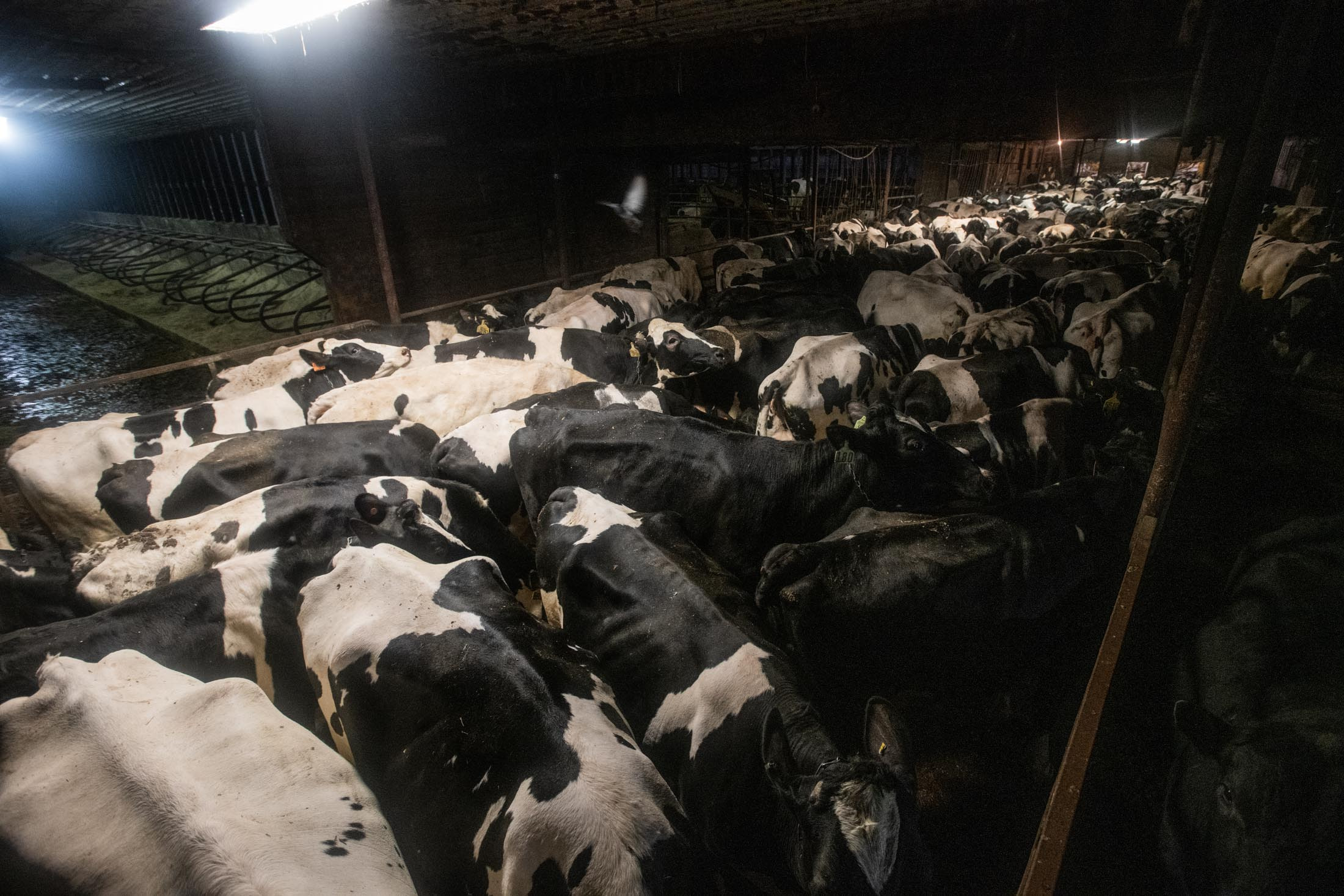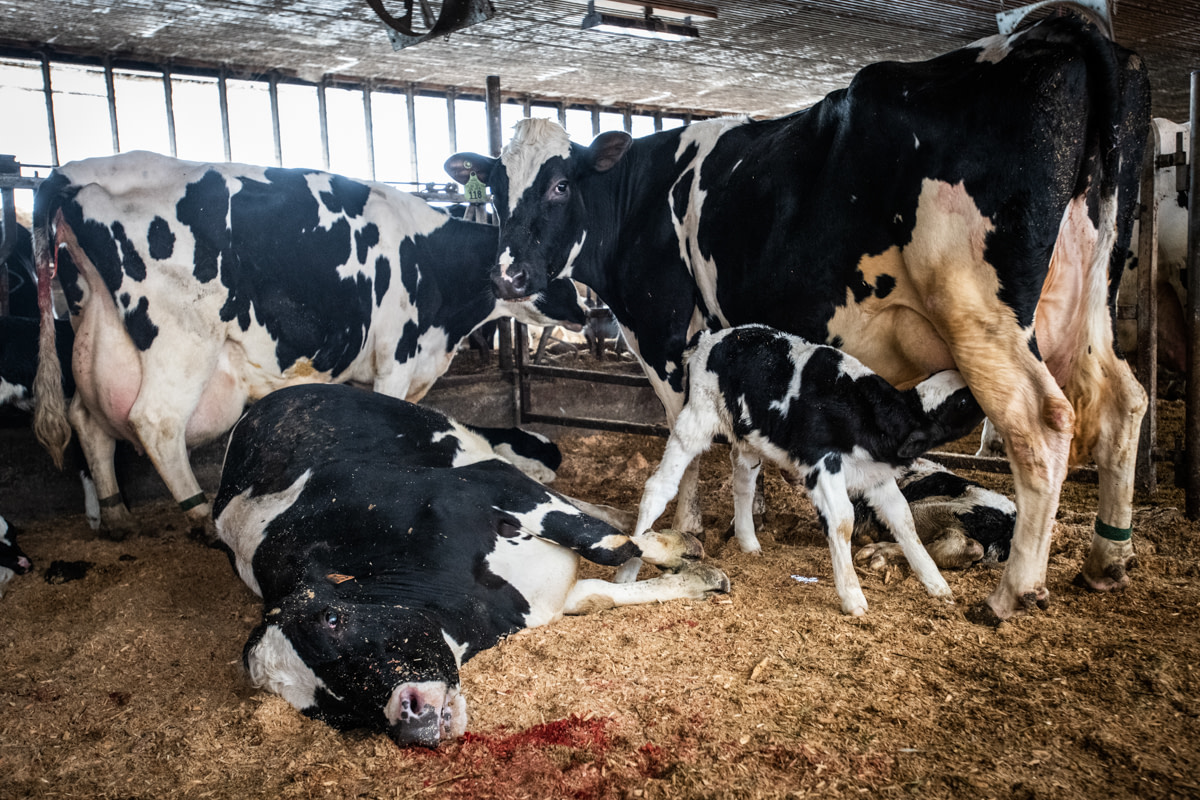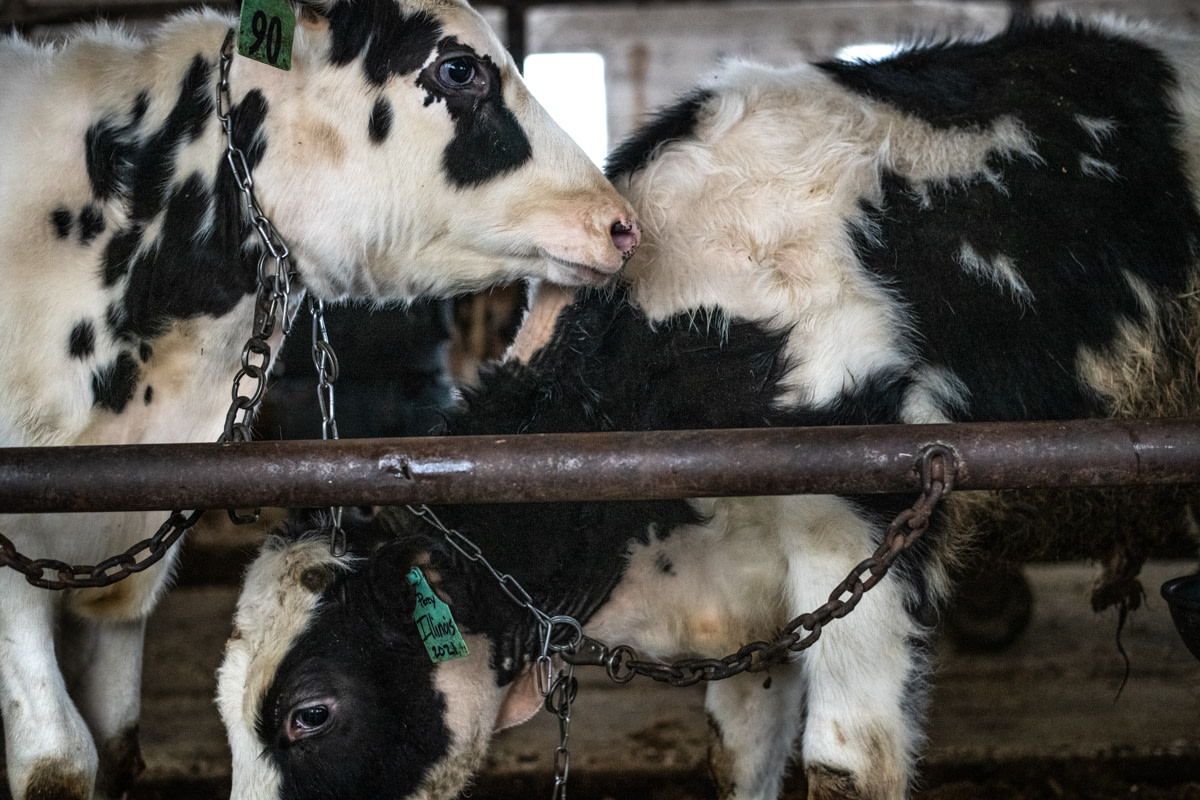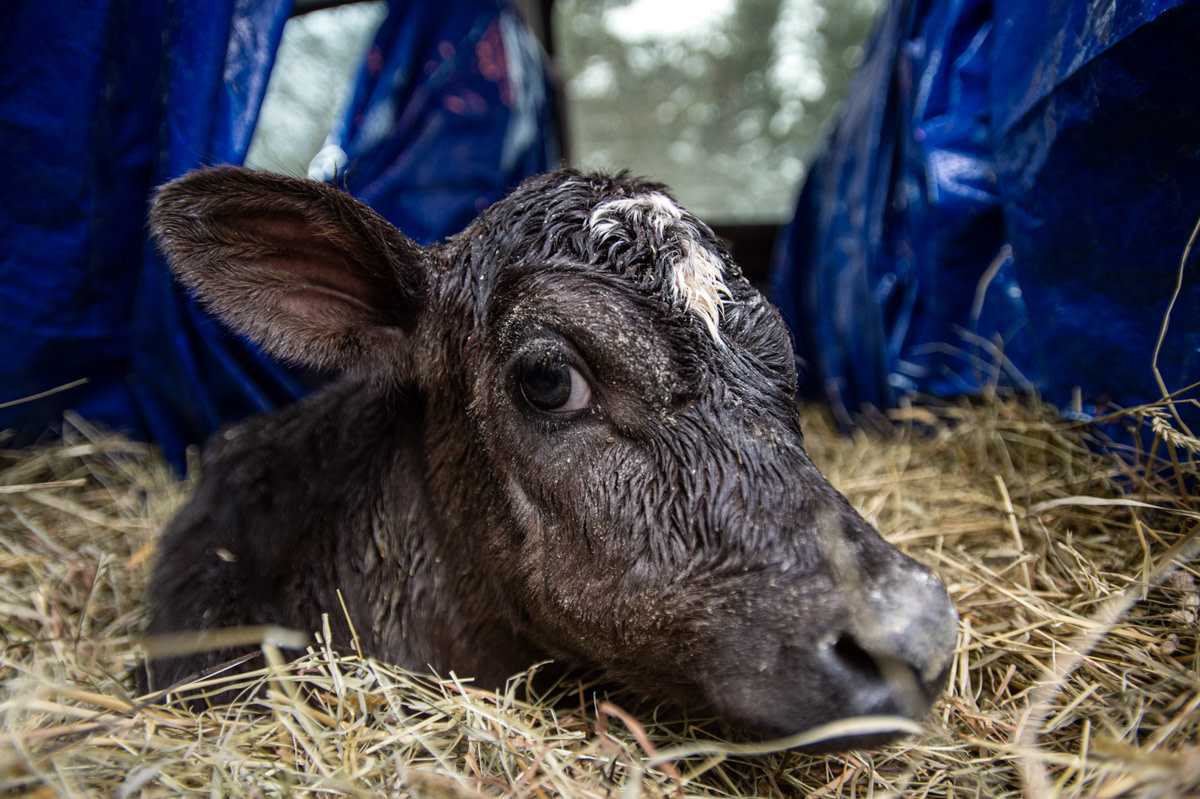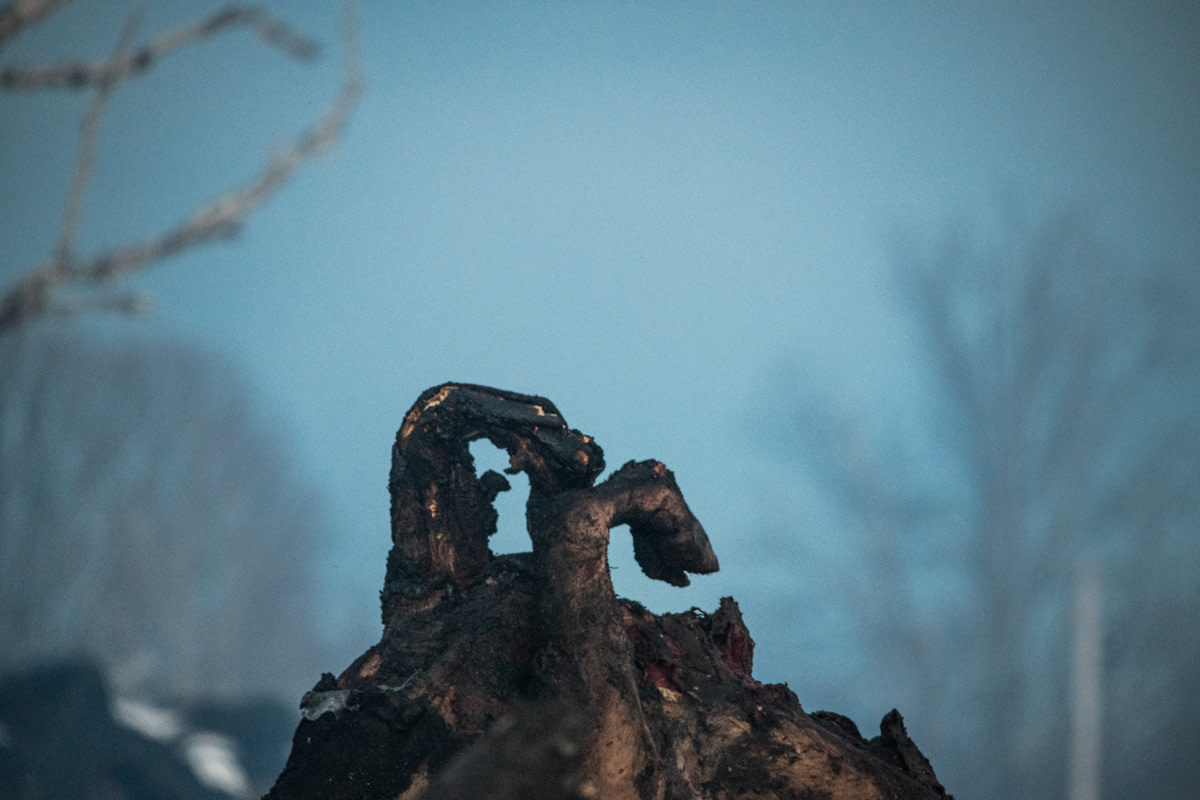Holstein cows are ushered into the centre of a barn which leads to the milking parlour at a dairy farm in Vermont. During the winter months, typically between November and May, they live here indoors. USA, 2022.
Jo-Anne McArthur / We Animals
[Content warning: Contains confronting images and/or video footage]
Dairy is facing an environmental reckoning. The land use, the water use and the methane are adding up in our collective minds to an unsustainable industry. But the way we treat dairy cows is beyond unsustainable.
On assignment for The Guardian, Jo-Anne McArthur joined Jason Bolalek, Founder of Destination Liberation in Vermont, USA, to document a calf rescue and the reason why so many calves are being shot.
Photographer: Jo-Anne McArthur
“If there’s one thing that’s always the same about an investigation, it’s that what unfolds will differ vastly from my expectations.” ― Jo-Anne McArthur
The state of Vermont is known for its dairy farming and milk production. In 2019, cows there produced 2.7 billion gallons of milk, with an estimated 135,000 cows currently living in the state. Each year, more small farms close, and larger farms increase their capacity to hold cows and produce more milk.
During her time in Vermont, Jo-Anne photographed the remains of a dairy barn that burned down just a few days before she arrived, where 130 Jersey cows burned alive inside. She photographed cows slipping around on slick concrete floors as they are ushered to the milk parlour. She photographed, in a single pen, a dead mother, shivering and sick calves, while other new mothers stand next to and over the dead mother while their babies try to suckle. Those families were then separated.
The images of cows in fields that we see on milk cartons are a far cry from reality.






















Vermont, USA, 2022.
Jo-Anne McArthur / We Animals
On commercial dairy farms, calves are removed from their mothers shortly after birth. Some calves are killed, while others are raised for veal or the milking line. It has been well documented that both mother and calf show visible signs of distress for days or even weeks after being separated.
The majority of dairy cows and calves are kept indoors for the duration of the winter months, many in tie-stall systems. In the barns visited during this assignment, cows under a year old were kept chained, only able to stand up and lie down.
“In the span of a few days I’ve taken thousands of photographs of these animals chained by their necks, where they will stay, unable to turn around, from November until May.” ― Jo-Anne McArthur
At this farm, calves and young Holstein cows who are slated for life in the dairy industry live indoors all winter, chained by their necks. Between the months of November to April or May, they are only able to stand up and lie down. USA, 2022.
Jo-Anne McArthur / We Animals
It may seem incomprehensible for a farmer to shoot a calf. For many of us who follow dairy practices, we know males calves are often sold as veal or beef after being auctioned and sent to feedlots. But with regulations changing in the beef industry, and conglomerates taking over, it is less expensive to kill calves shortly after their birth than to raise them even for a few weeks to meet the minimum slaughter weight of 75lbs. These males can’t produce milk, and they can’t be sold as beef at a profit. Their births aren’t recorded, so it’s unknown how many hundreds of thousands are killed each year in the USA. Estimates of the practice in the UK put the figure at around 95,000. And we know that there are roughly 10 million dairy cows in the USA.
Activist Jason Bolalek leaves a dairy farm with a calf who was slated to be killed because she is an unwanted mixed-breed. The farmers agree to let Jason take calves and find them happy private homes or sanctuaries where the calves are allowed to grow and live out their lives. This calf was named Cici by her adoptive family at Mockingbird Farm Sanctuary. USA, 2022.
Jo-Anne McArthur / We Animals
During her time on assignment, Jo-Anne was able to document the rescue of a calf by animal rights activist Jason Bolalek. Over the course of three years and with permission from farmers, Bolalek has rescued and helped rehome unwanted calves from the dairy industry in Vermont. To date, over 70 calves have gone to sanctuaries and suitable private homes, thanks to Destination Liberation.
A new born calf is rescued from a dairy farm by activist Jason Bolalek. Here, she lies in some straw in the back of Bolalek’s truck. She will be transported to veterinary care at Cornell University and then to her new home at Mockingbird Farm Sanctuary. USA, 2022.
Jo-Anne McArthur / We Animals
Bolalek was granted permission to take the newly born calf because she was a mixed breed of Holstein and Jersey. Because she would only fetch a few dollars at auction (even as little as $3 USD) once she was fed enough to reach 75lb, she was not worth the investment of powdered milk and hay, and would be shot. Through Bolalek’s outreach, he found a home for her at Mockingbird Farm Sanctuary, who named her Cici. At the time of writing, Cici is still recovering from severe illness at Cornell Veterinary Hospital.
“We need to see the heartbreaking reality of dairy production. We have a duty to see the effects of these horrendous industries and do something to alleviate the pain.” ― Jo-Anne McArthur
When exposés of farms like this surface, the industry is quick to say that they represent one bad farm, or one bad day. But how is it that all of these nightmarish scenes unfolded to us in every barn we entered; barns owned by respected members of the community?
The charred bodies of the 130 Jersey cows who died in a barn fire are moved from the burn site to an area nearby where they will be composted. USA, 2022.
Jo-Anne McArthur / We Animals
Data sources: USDA, The Guardian, Compassion in World Farming, Statista.com
Photographer: Jo-Anne McArthur
Explore and download visuals from this investigation via our stock platform.

